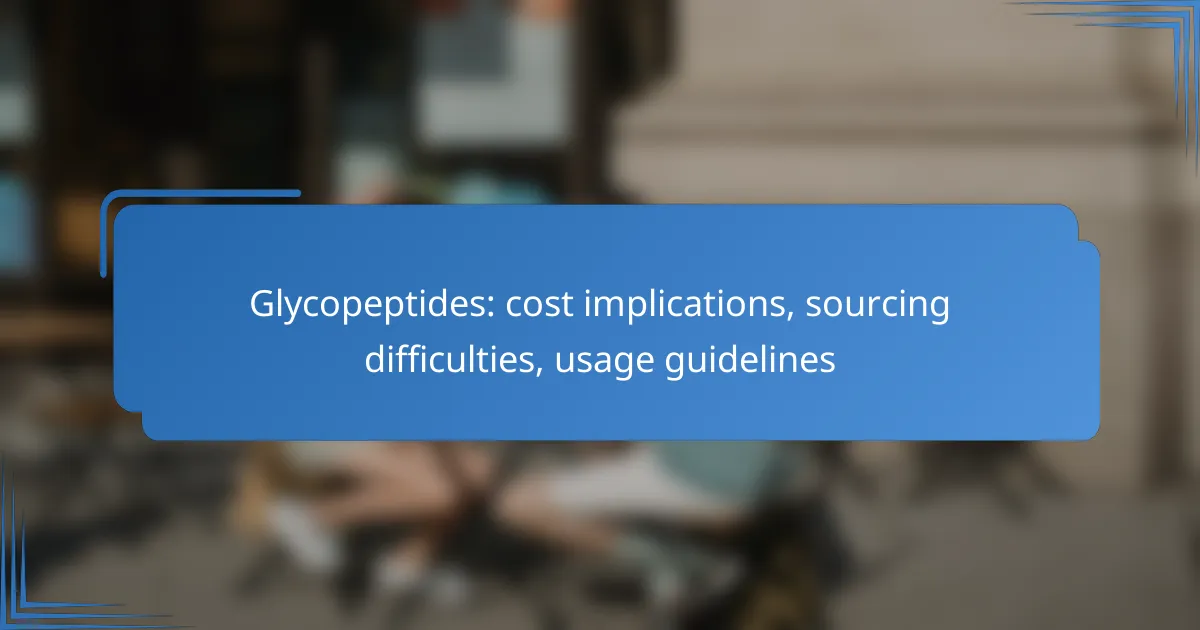Glycopeptides are critical antibiotics used to treat serious infections caused by Gram-positive bacteria, often at a higher cost due to sourcing challenges and market demand. In Canada, understanding the complexities of sourcing these medications, including navigating regulatory frameworks and identifying reliable suppliers, is essential for ensuring quality and availability. Adhering to proper usage guidelines is crucial for maximizing their effectiveness and ensuring patient safety.

What are the cost implications of glycopeptides in Canada?
The cost implications of glycopeptides in Canada can be significant, influenced by factors such as sourcing challenges and market demand. These antibiotics, often used for serious infections, may come at a premium compared to other treatment options.
Pricing trends for glycopeptides
In Canada, the pricing of glycopeptides has shown an upward trend over recent years, primarily due to increased demand and limited suppliers. Prices can vary widely, typically ranging from several hundred to over a thousand Canadian dollars per treatment course, depending on the specific drug and formulation.
Generic versions are becoming more available, which may help stabilize prices, but brand-name options still dominate the market. Monitoring pricing trends is essential for healthcare providers to manage budgets effectively.
Factors affecting glycopeptide costs
Several factors influence the costs of glycopeptides in Canada. Sourcing difficulties, such as limited manufacturers and raw material shortages, can drive prices higher. Additionally, regulatory requirements for quality and safety can add to production costs.
Market dynamics, including competition and demand for alternative antibiotics, also play a role. As antibiotic resistance becomes a growing concern, the reliance on glycopeptides may increase, further impacting their pricing structure.
Comparison with other antibiotics
When compared to other antibiotics, glycopeptides generally have a higher cost due to their specialized use in treating resistant infections. For instance, while common antibiotics like penicillin may cost tens of dollars per course, glycopeptides can reach hundreds or more.
However, the effectiveness of glycopeptides in treating serious infections often justifies their higher price. Healthcare providers should weigh the cost against the potential outcomes when considering treatment options for patients.

How to source glycopeptides effectively in Canada?
Sourcing glycopeptides in Canada requires understanding the market, identifying reliable suppliers, and navigating regulatory frameworks. Focus on established distributors and manufacturers that comply with Health Canada standards to ensure quality and availability.
Top suppliers of glycopeptides
Some of the leading suppliers of glycopeptides in Canada include companies like Peptide Sciences, GenScript, and Thermo Fisher Scientific. These suppliers are known for their quality products and reliable delivery services.
When selecting a supplier, consider factors such as product range, pricing, and customer support. It’s beneficial to request samples or references to evaluate the supplier’s reliability before making larger purchases.
Challenges in sourcing glycopeptides
Sourcing glycopeptides can pose several challenges, including fluctuating prices and limited availability of specific peptides. Market demand can lead to shortages, making it essential to establish long-term relationships with suppliers.
Additionally, the complexity of glycopeptide synthesis may result in variations in quality. Always verify the supplier’s quality assurance processes and certifications to mitigate risks associated with sourcing.
Regulatory considerations for sourcing
In Canada, glycopeptides are subject to regulations set by Health Canada, which oversees the safety and efficacy of pharmaceutical products. Ensure that any sourced glycopeptides meet the necessary compliance standards to avoid legal issues.
It’s advisable to stay updated on any changes in regulations that may impact sourcing. Engaging with a regulatory consultant can provide valuable insights into navigating the compliance landscape effectively.

What are the usage guidelines for glycopeptides?
Glycopeptides are primarily used to treat serious infections caused by Gram-positive bacteria, particularly when other antibiotics are ineffective. Proper usage guidelines include recommended dosages, indications for use, and precautions to ensure safety and efficacy.
Recommended dosages for adults
The recommended dosage of glycopeptides, such as vancomycin, typically ranges from 15 to 20 mg/kg every 8 to 12 hours, depending on the severity of the infection and the patient’s renal function. For patients with renal impairment, dosage adjustments are necessary to prevent toxicity.
Monitoring serum levels is crucial, especially in severe infections, to ensure therapeutic levels are achieved without reaching toxic levels. Regular checks can help adjust dosages as needed based on individual patient response.
Common indications for glycopeptide use
Glycopeptides are commonly indicated for the treatment of conditions like methicillin-resistant Staphylococcus aureus (MRSA) infections, endocarditis, and severe skin infections. They are also used in cases of pneumonia caused by resistant organisms.
In addition to treating infections, glycopeptides may be used prophylactically in certain high-risk surgical procedures to prevent infections in patients with known allergies to beta-lactam antibiotics.
Precautions and contraindications
Precautions when using glycopeptides include monitoring for potential nephrotoxicity and ototoxicity, particularly in patients with pre-existing kidney conditions. It is essential to assess renal function before initiating therapy and during treatment.
Glycopeptides are contraindicated in patients with known hypersensitivity to the drug or its components. Additionally, caution should be exercised in patients receiving concurrent nephrotoxic medications, as this can increase the risk of adverse effects.

What are the alternatives to glycopeptides?
Alternatives to glycopeptides include various antibiotic classes and emerging therapies that can effectively treat infections caused by resistant bacteria. These options may vary in efficacy, cost, and availability, making it essential to consider specific circumstances when selecting a treatment.
Other antibiotic classes
Other antibiotic classes that can serve as alternatives to glycopeptides include beta-lactams, such as penicillins and cephalosporins, as well as aminoglycosides and macrolides. Each class has its own mechanism of action and spectrum of activity, which can be advantageous depending on the type of infection being treated.
For instance, beta-lactams are often effective against a wide range of gram-positive and gram-negative bacteria, while aminoglycosides are typically reserved for severe infections due to their potential toxicity. It’s important to assess the patient’s specific needs and the resistance patterns in the local area when choosing an antibiotic.
Emerging therapies
Emerging therapies, such as bacteriophage therapy and antimicrobial peptides, are being explored as alternatives to traditional antibiotics, including glycopeptides. Bacteriophage therapy utilizes viruses that specifically target and kill bacteria, offering a tailored approach to treatment.
Antimicrobial peptides, on the other hand, are naturally occurring molecules that can disrupt bacterial membranes. While these therapies show promise, they are still largely in the experimental stage and may not yet be widely available or covered by insurance. Healthcare providers should stay informed about ongoing research and clinical trials to consider these options for patients with resistant infections.

What are the future trends in glycopeptide usage?
Future trends in glycopeptide usage are increasingly focused on innovative formulations and addressing the challenges posed by antibiotic resistance. As healthcare evolves, the demand for effective glycopeptide therapies is likely to grow, necessitating advancements in sourcing and application guidelines.
Innovations in glycopeptide formulations
Innovations in glycopeptide formulations aim to enhance efficacy and reduce side effects. New delivery methods, such as liposomal formulations, are being explored to improve bioavailability and patient compliance. Additionally, combination therapies that pair glycopeptides with other antibiotics are gaining traction to broaden their effectiveness.
Research is also focusing on modifying existing glycopeptide structures to overcome resistance mechanisms. These novel compounds may offer improved potency against resistant strains, making them valuable in clinical settings.
Impact of antibiotic resistance on glycopeptide use
Antibiotic resistance significantly impacts glycopeptide use, as resistant bacterial strains diminish the effectiveness of standard treatments. This challenge has led to increased scrutiny of glycopeptide prescribing practices and a push for more judicious use to preserve their efficacy.
Healthcare providers are encouraged to adopt guidelines that prioritize susceptibility testing before initiating glycopeptide therapy. This approach ensures that these powerful antibiotics are reserved for cases where they are most needed, helping to mitigate the risk of further resistance development.
